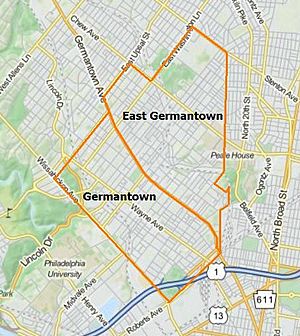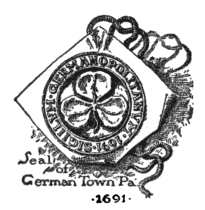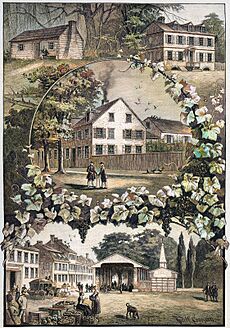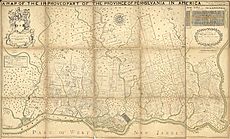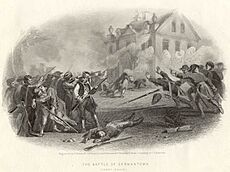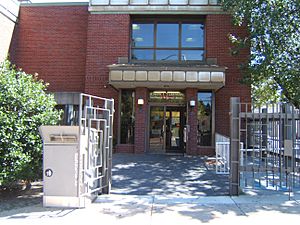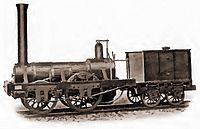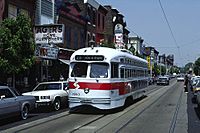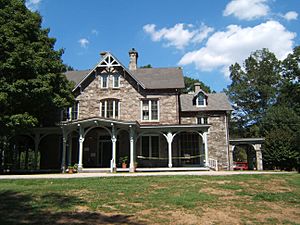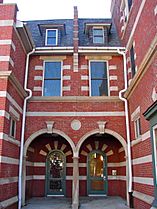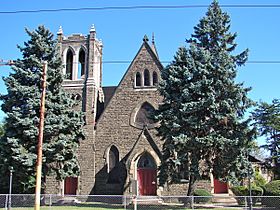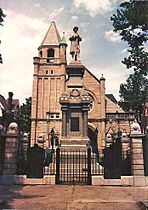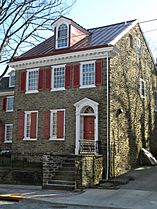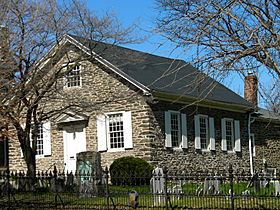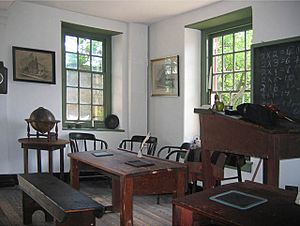Germantown, Philadelphia facts for kids
Quick facts for kids
Germantown, Philadelphia
|
|
|---|---|
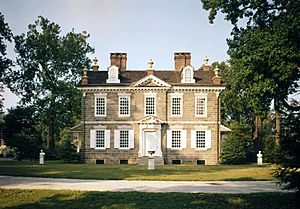
Cliveden, a house in Germantown built between 1763 and 1767
|
|
| Country | |
| State | |
| County | |
| City | |
| Founded | October 6, 1683 |
| Incorporated | August 12, 1689 |
| Consolidated | February 2, 1854 |
| Founded by | Francis Daniel Pastorius |
| Area | |
| • Total | 3.327 sq mi (8.62 km2) |
| Elevation | 240 ft (70 m) |
| Population
(2010)
|
|
| • Total | 75,935 |
| • Density | 22,824/sq mi (8,812.3/km2) |
| Demonym(s) | Germantowner |
| Time zone | UTC−5 (EST) |
| ZIP Codes |
19144, 19138
|
| Area code(s) | 215 |
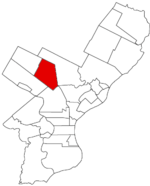
Germantown is a historic area in Northwest Philadelphia, Pennsylvania. It was founded in 1683 by families from Europe, including Palatine, Quaker, and Mennonite groups. For many years, Germantown was its own independent town. However, in 1854, it became part of the larger city of Philadelphia.
This area is about six miles northwest of downtown Philadelphia. Today, it is divided into two neighborhoods: 'Germantown' and 'East Germantown'.
Germantown has played a very important role in American history. It was where the first movement against slavery in America began. It was also the site of a major Revolutionary War battle. Even George Washington, the first president, lived here for a short time. Many famous politicians, thinkers, artists, and social activists have also called Germantown home.
Today, Germantown is still full of amazing historic sites and buildings from the colonial era. Some of these places are open for visitors to explore.
Contents
Exploring Germantown's Borders
Germantown stretches for about two miles along Germantown Avenue. This avenue runs northwest from Windrim and Roberts Avenues.
The area has always had clear boundaries on its southwest, southeast, and east sides. These are Wissahickon Avenue, Roberts Avenue, Wister Street, and Stenton Avenue. However, its northwest border has changed over the years.
When Germantown first became a town in 1689, Washington Lane separated it from the rural Germantown Township. Later, the border moved to Carpenter and East Gorgas Lanes. Then, in 1846, it went back to Washington Lane. This remained the border until Germantown became part of Philadelphia in 1854.
Today, the western part of the old town is simply called 'Germantown'. Sometimes, people call it 'West Germantown'. The eastern part is known as 'East Germantown'. The exact line between these two neighborhoods can be a bit blurry. Generally, 'Germantown' refers to the area west of Germantown Avenue, up to West Johnson Street. 'East Germantown' is the area east of Germantown Avenue, up to East Upsal Street.
Germantown is surrounded by other Philadelphia neighborhoods. To the northwest is Mount Airy. To the northeast are Ogontz and West Oak Lane. Logan is to the east, and Nicetown–Tioga is to the south. To the southwest, you'll find East Falls.
Most of Germantown uses the 19144 zip code. However, the area north of Chew Avenue is in the 19138 zip code.
A Look at Germantown's Past and People
Germantown was founded on October 6, 1683. This date is now celebrated as German-American Day in the United States. However, many of the first families who came here were actually Dutch, not Germans. These families were mostly Quaker and Mennonite. They had moved to places like Krefeld to escape religious persecution.
The town was named Germantown by its leader, Franz Pastorius. He was a German preacher. For many years, most people in Germantown spoke Dutch. After 1709, many Dutch families moved west. Then, many German immigrants arrived in Germantown and Pennsylvania. Pastorius, who was educated and a legal expert, helped record the town's German roots.
In 1688, just five years after Germantown was founded, it became the birthplace of the anti-slavery movement in America. Pastorius and three other men wrote a powerful letter against slavery. They sent it to their Quaker church leaders. This letter was based on the Bible's Golden Rule: "Do unto others as you would have them do unto you." Even though the church didn't act right away, this letter started the process. Eventually, the Society of Friends banned slavery in 1776, and Pennsylvania banned it in 1780.
In 1723, Germantown became home to the first Schwarzenau Brethren congregation in the New World. Many churches, like the Church of the Brethren, trace their beginnings back to this group.
During the American Revolutionary War, the British army occupied Philadelphia. British soldiers stayed in Germantown. On October 4, 1777, the Continental Army attacked them in the Battle of Germantown. During the fight, some civilians even shot at the British. The Americans ended up firing on each other by mistake and had to retreat. The British won this battle. However, the American victory at Saratoga later that month led to France officially recognizing America. France then became an ally of the Americans.
During his time as president, George Washington and his family lived in the Deshler-Morris House in Germantown. They moved there to escape a yellow fever outbreak in Philadelphia in 1793. The first bank of the United States was also located here during his presidency.
In 1854, Germantown officially became part of the City of Philadelphia.
Over time, the people living in Germantown changed. In the late 1800s, Italian families began to settle here. In the early 1900s, many African Americans moved to Philadelphia from the South during the Great Migration. This led to many German, Scots-Irish, and Irish families moving to Germantown.
After World War II, more African Americans moved to Philadelphia. Because of housing shortages in other areas, many moved to Northwest Philadelphia, including Germantown. This led to new homes being built. The city also helped create public housing for these new families.
Between 1954 and 1956, more African American families moved into southern Germantown. This led to changes in property values. Many white residents then moved to the suburbs. This shift also caused the shopping district in central Germantown to decline. The last department store closed in the early 1980s.
Today, Germantown is a diverse neighborhood. According to the 2010 US Census, Germantown is mostly Black (77%), with 15% white residents. East Germantown is 92% Black.
Learning in Germantown
Schools for Young Learners
Public Schools
All of Philadelphia, including Germantown, is part of the School District of Philadelphia. Here are some of the public schools in Germantown:
- Anna L. Lingelbach School (Kindergarten to 8th grade)
- John B. Kelly School (Kindergarten to 6th grade)
- John Wister Elementary School (Kindergarten to 6th grade)
- Hill Freedman Middle School (6th to 8th grade)
- Theodore Roosevelt Middle School (7th to 8th grade)
- Fitler Academics Plus School (1st to 8th grade)
- Martin Luther King High School (9th to 12th grade)
The Robert Fulton Elementary School and Germantown High School both closed in 2013.
Charter Schools
Mastery Charter Schools runs the Mastery Charter Pickett Campus (7th to 12th grade) in Germantown. This school opened in 2007. Other charter schools include Germantown Settlement Charter School (5th to 8th grade), Imani Education Circle Charter School (pre-Kindergarten to 8th grade), and Wissahickon Charter School's Awbury Campus (6th to 8th grade). The Pennsylvania School for the Deaf, a private school, is located where Germantown Academy used to be. Germantown Academy moved in 1965.
Private Schools
Germantown has several private schools:
- DePaul Catholic School (Kindergarten to 8th grade)
- Waldorf School of Philadelphia (Pre-Kindergarten to 8th grade)
- High Street Christian Academy (Kindergarten to 4th grade)
- Germantown Islamic School
- Green Tree School (special education, ages 6–21)
- Two Quaker schools: Germantown Friends School and Greene Street Friends School.
Other private schools nearby include:
- Mount Airy's Revival Hill Christian High School (9th to 12th grade)
- Blair Christian Academy (Pre-Kindergarten to 12th grade)
- Islamic Day School of Philadelphia (Pre-Kindergarten to 5th grade)
- Project Learn School (Kindergarten to 8th grade)
- Classroom on Carpenter Lane (Kindergarten to 2nd grade)
- Holy Cross School (Kindergarten to 8th grade)
- Chestnut Hill's Springside School (Pre-Kindergarten to 12th grade)
- Chestnut Hill Academy (Kindergarten to 12th grade)
- Crefeld School (7th to 12th grade)
The William Penn Charter School (Penn Charter), the oldest Quaker school in the world, is in nearby East Falls.
Colleges and Universities
La Salle University is partly in Germantown. Its west campus is located on the old Germantown Hospital property. Other colleges near Germantown include:
- Drexel University College of Medicine's Queen Lane Medical Campus
- Arcadia University
- Chestnut Hill College
- The Lutheran Theological Seminary at Philadelphia
- Philadelphia University
- Saint Joseph's University
Other Learning Places
Settlement Music School, the largest community arts school in the United States, has one of its six branches in Germantown.
The Free Library of Philadelphia runs public libraries. The Joseph E. Coleman Northwest Regional Library is in Germantown. It was named in 2002 after Joseph E. Coleman, a member of the Philadelphia City Council.
Getting Around Germantown
The very first railroad in Philadelphia was the Philadelphia, Germantown and Norristown Railroad. It connected Germantown to downtown Philadelphia in 1832. At first, horses pulled the trains! The inventor Matthias W. Baldwin built his first steam locomotive, called Old Ironsides, for this railroad. It could go up to 28 miles per hour.
Today, two SEPTA Regional Rail lines connect Germantown to Center City:
- The Chestnut Hill West Line stops at Queen Lane, Chelten Avenue, and Tulpehocken stations.
- The Chestnut Hill East Line stops at Wister, Germantown, and Washington Lane stations.
The neighborhood also has many bus routes. These include routes 18, 23, 26, 53, 65, H and XH, J, and K. Some of these bus routes used to be trolley lines.
Parks and Fun Places
Germantown has many parks and recreation areas where you can relax and play. These include:
- Awbury Arboretum, a historic 55-acre garden and estate
- Carpenter Park
- Clifford Park
- Cliveden Park
- Cloverly Park
- East Germantown Recreation Center
- Fernhill Park
- Germantown Cricket Club (private)
- Hansberry Garden and Nature Center
- Happy Hollow Playground
- Howell Park
- Kelly Playground
- Loudoun Park
- Vernon Park
- Waterview Recreation Center
- Wissahickon Valley Park (bordering), a large 1400-acre park that is part of the Fairmount Park system.
- Wister's Woods Park (bordering)
Historic Places to Visit
National Historic Landmark Districts
These are large areas recognized for their historical importance:
- Colonial Germantown Historic District
- Rittenhousetown Historic District
National Historic Districts
These districts are also recognized for their historical value:
National Historic Landmarks
These are individual buildings or sites with special historical significance:
- Cliveden, the estate of Benjamin Chew. This house was an important site during the Battle of Germantown and is open to the public.
- Germantown Cricket Club
- John Johnson House, a site on the Underground Railroad, which is open to the public.
- Charles Willson Peale House
- Wyck House, also open to the public.
National Register of Historic Places
Many other sites in Germantown are listed on the NRHP:
- Alden Park Manor
- Beggarstown School
- Conyngham-Hacker House
- Delmar Apartments
- Deshler-Morris House
- Fitler School
- Germantown Grammar School
- Grumblethorpe
- Howell House
- Loudoun Mansion
- Ebenezer Maxwell House
- Mayfair House
- Oaks Cloister
- Thomas Meehan School
- Mennonite Meetinghouse
- Charles Schaeffer School
- Upsala
- Grumblethorpe Tenant House
- St. Peter's Episcopal Church of Germantown
- William C. Sharpless House
- Smyser and English Pharmacy
- Sally Watson House
- Wyck House
- YMCA of Germantown
Gallery of Historic Architecture
For more historic buildings in the Colonial Germantown Historic District, see here.
- Selected historic architecture of Germantown
-
Grumblethorpe, 5267 Germantown Ave.
Other Historic Buildings and Sites
- Barron House
- Boxwood, 156 W. School House Lane, built 1897-98
- Concord School House
- The Francis Strawbridge House, Wissahickon Avenue
- The Germantown Boys' Club, 23 W. Penn Street, built 1898-1909
- Germantown High School, 5901-13 and 5915-41 Germantown Avenue
- Gilbert Stuart Studio
- Green Tree Tavern (Germantown)
- The Jonathan Graham House, 5356 Chew Avenue
- The King Green House, 5112-14 Germantown Avenue
- The Leibert House, 6950 Germantown Avenue, built around 1800-08
- Little Wakefield, 1701 Lindley Avenue
- Lower Burial Ground (Hood Cemetery)
- The Lutheran Theological Seminary Historic District, Mt. Airy
- The Connie Mack House
- The Methodist Episcopal Church of the Advocate, 5250 Wayne Avenue
- St. Michael's Lutheran Church, 6671 Germantown Avenue, Mt. Airy, built around 1728-1897
- Mitchell, Fletcher, & Co., Inc., 5708 Germantown Avenue, built around 1811-1911
- The Upper Burial Ground
- Vernon Park
- The Wachsmuth-Henry House, 4908 Germantown Avenue, built around 1760
- Woodside, The Dorfeuille-Hacker Country Seat, 339 E. Wister Street, built around 1797
Famous People from Germantown
Many notable people have lived in or are connected to Germantown:
- Herb Adderley, NFL Hall Of Fame defensive back
- Louisa May Alcott, author of Little Women
- M. K. Asante, filmmaker, professor, rapper, author
- James Barron, naval hero
- Frankie Beverly, R & B musician. A street in East Germantown is named in his honor.
- Bilal, singer-songwriter
- Samuel Blair, second Chaplain of the United States House of Representatives
- Anna Richards Brewster, painter
- Elaine Brown, Black Panther Party leader
- Martin Grove Brumbaugh, Governor of Pennsylvania
- Mary Carr, film actress
- George Washington Carpenter, scientist
- Benjamin Chew, Chief Justice of Pennsylvania
- Clarence Clark, professional tennis player
- Daniel Clark, Delegate to the U.S. House of Representatives
- Walter Leighton Clark, American businessman, inventor, and artist
- Joseph Sill Clark, Sr., tennis player
- Florence Van Leer Earle Coates, American poet
- William M. Colladay, Wisconsin politician
- John Conard, member of the U.S. House of Representatives
- Bill Cosby, comedian, actor, musician, author, educator
- Charles Darrow, credited inventor of the Monopoly game
- Marguerite de Angeli, writer and illustrator of children's books
- Amrit Desai, yogi, founder of the Kripalu Center
- Byron W. Dickson, college football coach
- George Ege, member of the U.S. House of Representatives
- James Engle, speaker of the Pennsylvania House of Representatives
- Lola Falana, singer, dancer, and actress
- Mantle Fielding, architect
- Sidney George Fisher, author
- Janet Gaynor, film, stage and television actress and painter
- Frederic Gehring, Catholic priest
- Henry Gibson, actor
- Walter B. Gibson, author known for The Shadow
- Thomas Godfrey, inventor of the octant
- William Newport Goodell, artist, craftsman, and educator
- Jacob C. Gottschalk, first Mennonite bishop in America
- Abraham op den Graeff, one of the first settlers of Germantown, merchant, politician
- Nelson Graves, Philadelphian cricketer
- Carolyn Green, competition swimmer and two-time Pan American Games gold medalist
- Albert M. Greenfield, businessman, political activist, philanthropist
- Rufus Harley, jazz musician
- Alfred C. Harmer, member of the U.S. House of Representatives
- Ross Granville Harrison, biologist and anatomist
- Charles Hoffner, pro golfer
- Bernard Hopkins, professional boxer
- Marcus Jastrow, Talmudic scholar
- Eve, rapper, actress
- Edwin Jellett, writer
- Lindley Johnson, Philadelphia architect
- Lloyd Jones, Olympic athlete
- Florence Kelley, social and political reformer
- Khia, rapper, record producer
- Florence Kirk, American soprano
- Adam Kuhn, physician, professor, and botanist
- Maggie Kuhn, activist, founder of the Gray Panthers
- Maxine Kumin, poet and author
- George Cochran Lambdin, Victorian flower painter
- George Landenberger, 23rd Governor of American Samoa
- Noyes Leech (1921–2010), law professor
- George Lippard, novelist, journalist, playwright, social activist
- Eric Lobron, German chess grand master
- James Logan, statesman
- Sarah Logan Wister Starr, humanitarian
- John W. Lord, Jr., Pennsylvania State Senator, Philadelphia City Councilman, United States District Judge
- Airrion Love, member of the R&B group The Stylistics
- G. Love, born Garrett Dutton III, front man of G. Love & Special Sauce
- Alexander Mack, leader of the German Baptists
- Connie Mack, the longest-serving manager in Major League Baseball history
- Abe Manley, sports executive
- J. Howard Marshall, wealthy magnate
- Logan Marshall, author
- John Alden Mason, archaeological anthropologist and linguist
- Jimmy McGriff, jazz musician
- Robert L. McNeil, Jr., developer of Tylenol
- Thomas Meehan, botanist and author
- Thomas Lynch Montgomery, historian and librarian
- George T. Morgan former chief engraver at the United States Mint
- Margaretta Morris, entomologist
- James K. Morrow, writer
- James St. Clair Morton (1829-1864), Military officer in the United States Civil War
- Eleanor Myers, archaeologist
- William Jackson Palmer, founder of Colorado Springs, Colorado
- Francis Daniel Pastorius, leader of the Germantown settlement
- James DeWolf Perry, Presiding Bishop of the Episcopal Church
- Christian Frederick Post, Moravian Church missionary
- Ellen Bernard Thompson Pyle, illustrator
- Sun Ra, Jazz musician
- Edmund Randolph, the first United States Attorney General
- Theodore William Richards, recipient of 1914 Nobel Prize in Chemistry
- Mary Davis Ridgway (1873–1927), physician
- David Rittenhouse, astronomer, mathematician, first director of the United States Mint
- William Rittenhouse, founded the first paper mill in the colonies
- Owen J. Roberts, Supreme Court Justice
- Ralph J. Roberts, co-founder and former CEO of Comcast
- Charley Ross, four-year-old kidnapping victim in 1874
- Charles Frederick Schaeffer, Lutheran clergyman
- Francis Schaeffer, Christian theologian
- William I. Schaffer, lawyer, Pennsylvania Attorney General and Supreme Court Justice
- J. Barney Sherry, silent film actor
- William Shippen, Philadelphia physician, civic and educational leader
- Benjamin Shoemaker, mayor of Philadelphia
- Ron Sider, founder of Evangelicals for Social Action
- Frederick Smith, lawyer, Pennsylvania Attorney General and Pennsylvania Supreme Court Justice
- Patti Smith, punk rock singer-songwriter, poet and visual artist
- Mike Sojourner, professional basketball player
- Christopher Sower the elder, printed the first German-language Bible in America
- Christopher Sower the younger, clergyman and printer
- Christopher Sower III, loyalist printer
- Martin Luther Stoever, Lutheran educator and writer
- Witmer Stone, ornithologist and botanist
- Gilbert Stuart, portrait artist
- Walter Stuempfig, Romantic realism artist
- Clyde Summers, lawyer and educator
- Thomas De Lage Sumter, U.S. Representative from South Carolina
- Frederick Winslow Taylor, engineer, management theorist, and consultant
- Meldrick Taylor, professional boxer
- Russell Thompkins, Jr., songwriter of the R&B group The Stylistics
- Bill Tilden, tennis player
- Henry van Dyke, author, educator, and clergyman
- George Washington, first president of the United States. Lived in Germantown briefly.
- Grover Washington, Jr., saxophonist
- Ora Washington, professional tennis player
- Jesse Watters, conservative political commentator
- William Walter Webb, Episcopal bishop
- Langhorne Wister, Civil War brevet brigadier general
- Owen Wister, author
- Sally Wister, diarist during the Philadelphia campaign
- Jeremiah Wright, Black theology pastor
- John Zacherle, television host, radio personality and voice actor
- PnB Rock, R&B singer, rapper, composer
- Mike Mentzer, Bodybuilder



